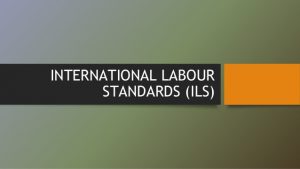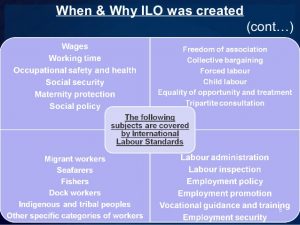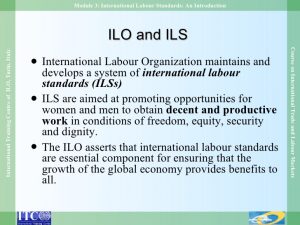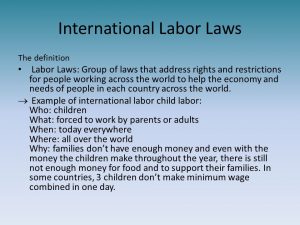International labor standards refer to conventions agreed upon by international actors, resulting from a series of value judgments, set forth to protect basic worker rights, enhance workers’ job security, and improve their terms of employment on a global scale. The intent of such standards, then, is to establish a worldwide minimum level of protection from inhumane labor practices through the adoption and implementation of said measures. From a theoretical standpoint, it has been maintained, on ethical grounds, that there are certain basic human rights that are universal to humankind. Thus, it is the aim of international labor standards to ensure the provision of such rights in the workplace, such as against workplace aggression, bullying, discrimination and gender inequality on the other hands for working diversity, workplace democracy and empowerment.
While the existence of international labor standards does not necessarily imply implementation or enforcement mechanisms, most real world cases have utilized formal treaties and agreements stemming from international institutions. The primary international agency charged with developing working standards is the International Labour Organization (ILO). Established in 1919, the ILO advocates international standards as essential for the eradication of labor conditions involving “injustice, hardship and privation”. According to the ILO, international labor standards contribute to the possibility of lasting peace, help to mitigate potentially adverse effects of international market competition and help the progress of international development.
Implementation, however, is not limited to the ILO nor is it constrained to the legislative model that the ILO represents. Other alternatives include direct trade sanctions, multilateral enforcement, and voluntary standards. In addition to controversies that arise over each of these models, greater issues have also been raised concerning the debate over the need for international labor standards themselves. However, while critics have arisen, the international community has largely come to a consensus in favor of basic protection of the world’s labor force from inhumane practices.
Associated with the development of successful international labor standards is proper monitoring and enforcement of labor standards. Most monitoring occurs through the ILO, but domestic agencies and other NGOs also play a role in the successful monitoring of international labor standards.
History
Early history
The concept of protecting workers from the perils of labor environments dates all the way back to 14th-century Europe. The first example of the modern labor rights movement, though, came in response to the brutal working conditions that accompanied the onset of the Industrial Revolution in the 18th and 19th centuries. In 1802, the Parliament of the United Kingdom passed what is now known as the English Factory Act. The act sought to regulate the workday of apprentices by restricting work hours to 12 per day. In doing so, the English Factory Act served as a precursor to the models of international labor standards seen today. Minimal regulations similar to those found in English legislation subsequently became increasingly commonplace among 19th century industrializing nations. Early attempts at the provision of labor standards were limited in scope, though. Such conventions focused primarily on improving working conditions in relation to hours of work, women’s and children’s labor, and the use of hazardous materials. While it was evident that support for workers’ rights was inconsistent across international boundaries, activists originally only employed the use of moral suasion to deal with differences in labor standards. It was not until the latter parts of the 19th century that efforts were made to implement uniform standards on an international scale.
The definition. Labor Laws: Group of laws that address rights and restrictions for people working across the world to help the economy and needs of people in each country across the world. Example of international labor child labor: Who: children What: forced to work by parents or adults When: today everywhere Where: all over the world Why: families don’t have enough money and even with the money the children make throughout the year, there is still not enough money for food and to support their families. In some countries, 3 children don’t make minimum wage combined in one day.
Creation of ILO
In 1919, following the end of the First World War, the agenda on international labor standards reached a new level of prominence as a result of the founding of the International Labour Organization. As mandated by Part XIII of the Treaty of Versailles, the ILO was created as a branch of the League of Nations in order to address all conceivable aspects of labor rights. Preliminary efforts focused primarily on the eradication of slavery and all forms of forced labor. The agenda quickly expanded, however, to include the rights to freedom of association and collective bargaining, nondiscrimination in employment, and the elimination of child labor. The ILO’s creation marked the first instance of multiple major international actors coming together in an attempt to reach a consensus on universal workers’ rights. Despite a lack of any formal means of coercion, the ILO then urged its 44 original member countries to adopt and ratify conventions limiting oppressive labor market practices.
The early years of the ILO
In the first two years of the ILO’s existence, 22 international labour conventions were adopted. Some of the topics that the first conventions addressed were “hours of work in industry, unemployment, maternity protection, night work for women, minimum age, and night work for young persons in industry.” In 1930, the ILO adopted the first future fundamental convention: the Forced Labour Convention (No.29), which prohibited all forms of forced labour unless exempted by certain conditions. With the onset of the Great Depression, the United States joined the ILO in 1934 noting that complex labor issues would require an international response. Throughout the history of the League of Nations, the ILO is the only League-affiliated organization that the United States joined. With the backdrop of World War 2, the ILO broadened its mandate with the Declaration of Philadelphia, signed during the 26th general conference session in 1944. The Declaration of Philadelphia, which is attached to the general constitution of the ILO, foreshadows some of the ILO’s earliest future fundamental conventions including the freedom of expression and association which was adopted in 1948 as Convention 87, Freedom of Association and Protection of the Right to Organise Convention.
Globalization and changing divisions of labor
In the first half of the 20th century, global divisions of labor were shaped largely by the practices of colonialism. Poorer countries exported natural resources to richer countries, which then manufactured and produced specialized goods. As many colonized nations achieved independence, developing nations in the global South took on increasingly protectionist policies in attempts to build up the manufacturing sectors of their economies, thus marking a shift in the global division of labor. However, toward the latter part of the 20th century, a number of factors saw protectionist measures fall. Such factors included rising labor costs in the north, advances in transportation and communication technologies, the liberalization of trade, and the deregulation of markets. In the midst of a changing international labor landscape, developing nations in the south took on a previously unseen domination of the labor-intensive manufacturing industry.
With the deregulation of major markets and significant increases in the volume of international trade, attempts to make manufacturing sectors more attractive to retailers saw extreme downward pressure placed on the quality of working conditions in lower income regions of the world. This gave rise to growing concerns about a global Race to the bottom, in which governments take part in the iterative loosening of labor protections in attempts to aid the international competitiveness of export-oriented industries. Fears of this nature consequently produced the notable increases in the discourse on international labor ethics that characterize the contemporary international human rights arena.
Models
The traditional model of labor standards regulation has been, for most of history, within-country or within-jurisdiction legislation and enforcement. However, this model may not be appropriate when competitors in a product market are located in different countries or jurisdictions with dissimilar labor standards. This concern opens up the discussion for the establishment of international labor standards, which, in turn, require international regulation, particularly in the context of global trade. However, determining an effective method of implementation of international labor standards has been an area of difficulty and an area that is highly contested. The following sections outline several existing models for the regulation of international labor standards based largely on work by Richard N. Block, Karen Roberts, Cynthia Ozeki and Myron J. Roomkin in their paper titled “Models of International Labor Standards”.
Legislative
The legislative model for implementing a set of international labor standards is the best known. This model involves the enactment and enforcement of labor standards by a legislative body across a union of countries. Social policies regarding employment and labor typically fall into three areas: free movement of labor, prevention of social dumping via low labor standards, and dialogue between labor and management. This model has been adopted by the European Community, part of the European Union, and is also the model taken by the International Labour Organization (ILO). Organizations, such as these, are given the authority, through a series of procedures, to then issue directives in any of these areas of labor policy. Member states must comply with these directives; however, what compliance actually means and entails is left to the discretion of each member state.
European Community (EC)
The European Community (EC) is a multigovernmental legislative structure that, through the Treaty of European Union (Maastricht) in 1992, the Treaty of Amsterdam in 1997, and various other agreements has promoted full economic integration of its member states. While it has issued a number of directives in nonlabor areas, the same cannot be said for matters concerning social policy and labor. However, some restrictions regarding health and safety have been adopted by the EC in an attempt to mitigate any inhumane practices, involving low health and safety standards, used for the sake of a competitive advantage.
For those members within the EC who favor the implementation of labor standards, there has been a push to ease the decision-making barriers to social legislation. On February 7, 1992, the signing of the Maastricht Treaty made it easier to pass legislation on less controversial issues, such as health and safety, nondiscrimination, and consultation with workers.
While the EC provides a structure for enacting legislation that applies across counties, the extent to which it can actually create international labor standards, even within its own confines, is limited. While these directives allow for labor concerns to be brought above the national level, the presence of philosophical differences among member states as well as constraints on state autonomy demonstrate barriers to this model. However, despite these difficulties and a complex decision-making structure designed to include consultation with the governments of all member states, the various EC policy-making institutions and the related parties have succeeded in creating cross-national legislation for labor standards under its social policy umbrella. Consequently, this model, as demonstrated by the EC, is a viable one for establishing labor standards on a cross-national basis. The difficulty lies in the duplication of this model elsewhere, due to the EC’s unique, integrated community that is the only such general multinational standard system in the world today.
ILO
The International Labour Organization (ILO) is a specialized agency of the United Nations, consisting of 183 member countries, that deals with labor issues. The ILO, by its existence, is the recognized international vehicle for raising international labor standards issues in a worldwide forum. No other model in existence is capable of performing this role. This organization establishes labor standards by means of both conventions and recommendations and has a tripartite governing structure – representing government, employers and workers. While ILO recommendations take more of the role of providing mere guidance to member states, the stronger form, ILO conventions, have the status of a treaty, which, in principle, is binding on the member countries that voluntarily ratify them. These represent benchmarks of strong labor standards towards which countries can strive by promulgating and enforcing national laws that comply with the conventions. It is through these means that the organization works to enforce international labor standards.
In 1998, the ILO International Labour Conference adopted the “Declaration on Fundamental Principles and Rights at Work” defining certain rights as “fundamental.” The Declaration commits member states to respect and promote these main principles, referred to as the core conventions, which are grouped into the following four categories (total of eight ILO conventions): freedom of association and the effective recognition of the right to collective bargaining, the elimination of forced or compulsory labor, the abolition of child labor, and the elimination of discrimination in respect of employment and occupation. The Declaration claims these rights to be universal, applying to all people in all States – regardless of level of economic development. The International Labour Conference regards these principles as so important that all member counties are obligated to comply with them, regardless of ratification status.
Alongside the fundamental conventions, the ILO has also identified four priority conventions or governance conventions. Crucial to the running of the international labour standards systems implemented by the ILO, the ILO recommends that member states ratify the following priority conventions: the Labour Inspection Convention (1947), the Labour Inspection (Agriculture) Convention (1969), the Triparte Consultation (International Labour Standards) Convention (1976), and the Employment Policy Convention (1964).
Issues with the ILO’s approach to implementing international labor standards come down to a question of universality amongst the conventions and member countries, with some arguing that flexibility is necessary to meet the needs of developing countries. These concerns gather around the idea that the race to expand exports or attract foreign investment can cause competition on the basis of labor costs, leading to a decline in international labor standards as governments either dismantle national laws that protect workers or weaken the enforcement of these laws. The underlying issue here is the connection between national incomes and the standards a country can feasibly support while remaining competitive. Other issues involve enforcement of these standards following ratification. The ILO provides a vehicle for investigating cases of noncompliance through representations, filed by employer or worker organizations, or complaints, lodged by another member that also ratified the convention. These are then sent to a committee that launches an investigation and report. This is followed by either acceptance of recommendations on steps the government may take to address the complaint or the request to submit the case to the International Court of Justice. Failure to comply may result in an incurred sanction from the organization.
Overall, the ILO structure essentially created a system of voluntary compliance with labor standards based on ratification of the established conventions. In general the enforcement system of representation and complaints has been successful – success being measured by the fact that only one representation or complaint has reached the most severe sanction. On the other hand, due to the absence of strong sanctions, the ILO lacks a strong enough deterrent factor for countries inclined to violate the standards the ILO upholds. Further, the “flexibility” of standards allows too much leeway for adaptation based on independent circumstances, diminishing the force of the conventions.




